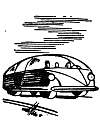|
A Radio Talk by Charles F. Kettering  Today -
according to the magazines and papers - we are standing on the
threshold of a new world - a world of new furniture, new houses, new
clothes, new cars with transparent tops, helicopters and airplanes -
all to be made largely of plastics. The writers about the plastic
industry may be too optimistic, yet no doubt many products will be
changed by these new materials. But, since people in general seem to be
much interested in this apparently new development, it might be worth
while, this afternoon, to review the story and see how the whole thing
started. Today -
according to the magazines and papers - we are standing on the
threshold of a new world - a world of new furniture, new houses, new
clothes, new cars with transparent tops, helicopters and airplanes -
all to be made largely of plastics. The writers about the plastic
industry may be too optimistic, yet no doubt many products will be
changed by these new materials. But, since people in general seem to be
much interested in this apparently new development, it might be worth
while, this afternoon, to review the story and see how the whole thing
started.To do this we must go back 80 years. At that time, billiards was the game of the day. But the one thing that kept it from being even more popular was a shortage of ivory which, as you know, comes from elephant tusks. In addition to making billiard balls, ivory was much used as the facing for piano keys. The shortage was so serious that one of the leading makers of billiard balls in the United States offered a prize of ten thousand dollars to the man who could make an acceptable substitute. In Albany, New York, a young printer and inventor, John Wesley Hyatt, saw in this prize a chance of a lifetime. For three years, principally at night and on Sundays, he made billiard balls out of wood, paper, glue, and hundreds of other things. |








